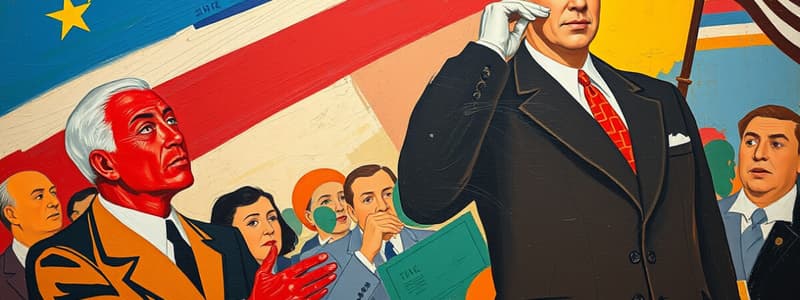Podcast
Questions and Answers
What major legislation was passed during Franklin D. Roosevelt's second New Deal?
What major legislation was passed during Franklin D. Roosevelt's second New Deal?
- The Civilian Conservation Corps
- The National Labor Relations Act (correct)
- The Emergency Banking Act
- The Federal Reserve Act
What was the purpose of Roosevelt's court-packing plan in 1937?
What was the purpose of Roosevelt's court-packing plan in 1937?
- To protect personal interests in the judiciary
- To reduce the size of the Supreme Court
- To eliminate judicial review power
- To increase the number of justices to ensure legislative support (correct)
Which event marked the abrupt end of Roosevelt's successes during the second New Deal?
Which event marked the abrupt end of Roosevelt's successes during the second New Deal?
- The economy's collapse into recession in 1937 (correct)
- The stock market crash of 1929
- The start of World War II
- The signing of the Social Security Act
How did Justice Owen J. Roberts influence the second New Deal legislation?
How did Justice Owen J. Roberts influence the second New Deal legislation?
What was a significant outcome of the New Deal period before the United States entered World War II?
What was a significant outcome of the New Deal period before the United States entered World War II?
Study Notes
Roosevelt's Second New Deal
- The Second New Deal (1935-1937) marked a shift from aggressive liberal policies of the First New Deal, reflecting a more cautious approach to federal power expansion.
- Key legislation enacted during the Second New Deal includes the Social Security Act and the National Labor Relations Act; both aimed at providing economic security and improving labor rights.
Court-Packing Plan
- In an attempt to safeguard his New Deal programs, Roosevelt proposed a court-packing plan in 1937, aiming to add a new Supreme Court justice for each existing member over age 70.
- The plan faced strong public opposition and was ultimately rejected.
- Despite this, Justice Owen J. Roberts played a crucial role in supporting the constitutionality of New Deal legislation.
Economic Challenges
- In 1937, a significant economic downturn occurred, leading to a recession that interrupted Roosevelt's prior successes.
- The economy experienced stagnation throughout the remainder of the 1930s.
- Although New Deal measures alleviated some suffering, the Great Depression did not fully end until the United States' involvement in World War II.
Studying That Suits You
Use AI to generate personalized quizzes and flashcards to suit your learning preferences.
Description
Explore the significant developments of Franklin D. Roosevelt's Second New Deal from 1935 to 1937. This quiz covers key legislation like the Social Security Act and the National Labor Relations Act, as well as Roosevelt's strategies to ensure the passage of his policies. Test your knowledge on the pivotal moments of this period in American history.




